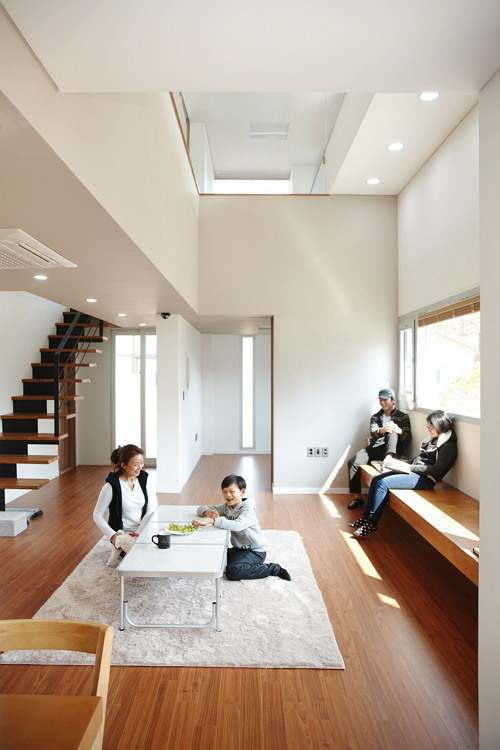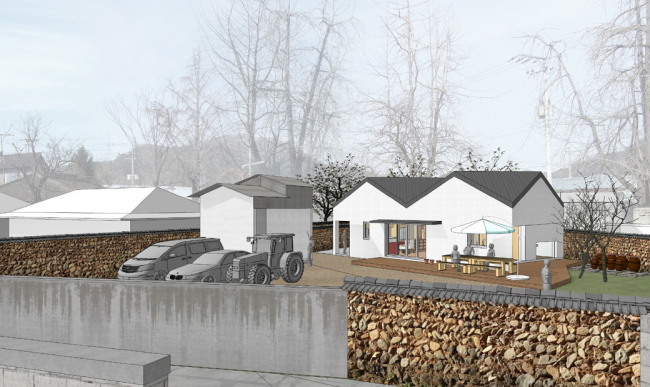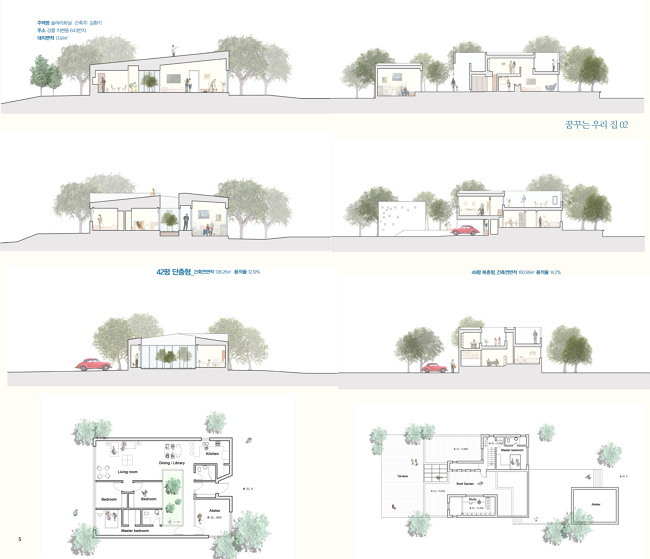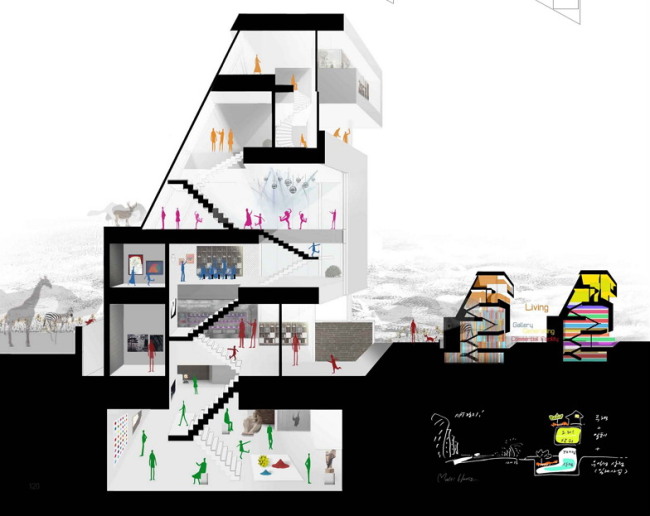[Weekender] ‘HOUSHOW’ brings dream houses to life
By Lee Woo-youngPublished : Dec. 12, 2014 - 21:40
The Association of Young Architects launched the HOUSHOW initiative, a dream house-building project, in 2012. For the first project, it selected six candidates among 80 applicants and then met with them in person to discuss the design of their dream house. As a gift, the project offered them a floor plan, a perspective drawing and a model so that they could build the actual house one day. Below is the brief introduction of four such houses.
01. Raon Haus
A couple in their early 40s with two young children wanted to live in a quiet suburban town that reminds them of their childhood in a rural village. A few years ago, they bought a small piece of land in Gapyeong, Gyeonggi Province, just an hour’s drive from Seoul, to realize the dream someday. The dream came true, and much earlier than expected, when Cho Young-mee met architect Lee Ki-ok last year. Lee designed the small scenic white house for the family.
01. Raon Haus
A couple in their early 40s with two young children wanted to live in a quiet suburban town that reminds them of their childhood in a rural village. A few years ago, they bought a small piece of land in Gapyeong, Gyeonggi Province, just an hour’s drive from Seoul, to realize the dream someday. The dream came true, and much earlier than expected, when Cho Young-mee met architect Lee Ki-ok last year. Lee designed the small scenic white house for the family.

The house, nicknamed “gallery house” by neighbors, overlooks a low mountain and has a stream running through the village close to it. The two-story house is small in size, but look spacious.
Glass walls extend the indoor space and offer a breathtaking view of the mountain.
The first floor is designed as a lounge and a kitchen where the couple can accommodate guests or business partners and clients.
The stairs leading up to the second floor is designed to give more space to the corridor. The second floor has a master bedroom equipped with a private bathroom, a bookshelf and a home bar, and a room for their children.
02. Dream Making House
The “Dream Making House,” a small house in Jangseong-gun, South Jeolla Province, came from the concern over the decreased number of family members.
For houses in the countryside, this is a bigger problem than those in the city because it would create more empty houses and surplus spaces.
For her dream house project, Cha Seo-hee thought about her father, who is living alone in the countryside. The neighborhood, full of trees and old houses, looks just as it did in the old days. There is farming equipment all around the house, with a tractor in the front yard.

“This 100-year-old house is full of memories of my family. It is also where my father will spends the rest of his life,” said Cha. “I want it to be a place where my brothers and sisters come and stay and neighbors come and visit.”
Cha suggested two concepts to Opus Architects, a group of three architects Woo Dae-sung, Cho Seong-ki and Kim Hyeong-jong, a house with an attic or a shared house.
The former would be small in size, but the attic could be used as rooms for visitors who want to stay overnight.
The latter would be used by all the neighbors ― mostly seniors. In this case, the living expenses can be shared by all of them.
The house was too old for reconstruction, but instead, architects used the wood from its pillars and ceilings for the construction of the new house. The old materials blend well with the neighborhood and the landscape.
03. Solmeori Art Studio
Kim Hwan-ki, a high school art teacher, wanted to build a house that he could use as an art studio and a gallery in Gangneung, Gangwon Province, where he lives with his wife and two daughters.
He even named it as “Solmeori Art Studio” and wanted it to be a simple U-shaped modern house.

The main focus of the project was to have efficient use of space with minimum expenses. Such an idea made him suggest two types of houses ― a one-story house or slightly bigger two-story house.
Architect Park Jong-hyuk of Park and Kim Architects discussed with the art teacher to deliver the best outcome.
The one-story house would have a garden inside that opens up the house space. The garden would also help save energy by functioning as a greenhouse in winter or a cool place to rest in summer under the shade of trees.
Meanwhile, the two-story house would be designed with a low ceiling in order to maximize the energy efficiency.
The rooms, including the study, children’s room and master bedroom, would be separated from each other to secure a sense of privacy, and yet all rooms would be connected in some ways so that the family can communicate with each other.
04. Multi House
The Multi House, located at the foot of Mount Bukhansan in Seoul, was designed to be flexible enough to react to the fast-changing lifestyle in urban areas.
Je Mi-seong wanted a house she could live in, but also use as a workplace. She wanted it to accommodate the private study academy she currently runs. She predicted that the area in Yeokchon-dong would be bustling with soon-to-be developed apartment complexes and new roads that connect the area to other neighborhoods.

She also wanted the house to reflect some major changes in her family. Her two grown-up children left home and the couple would have the house all to themselves. She wanted to utilize empty rooms and space for diverse purposes. Their married children can come and stay in the future or the couple can rent the space to others and generate income when they get old.
By Lee Woo-young and Lee Hee-ju
(wylee@heraldcorp.com) (hjlee0301@heraldcorp.com)








![[KH Explains] How should Korea adjust its trade defenses against Chinese EVs?](http://res.heraldm.com/phpwas/restmb_idxmake.php?idx=644&simg=/content/image/2024/04/15/20240415050562_0.jpg&u=20240415144419)










![[Today’s K-pop] Stray Kids to return soon: report](http://res.heraldm.com/phpwas/restmb_idxmake.php?idx=642&simg=/content/image/2024/04/16/20240416050713_0.jpg&u=)